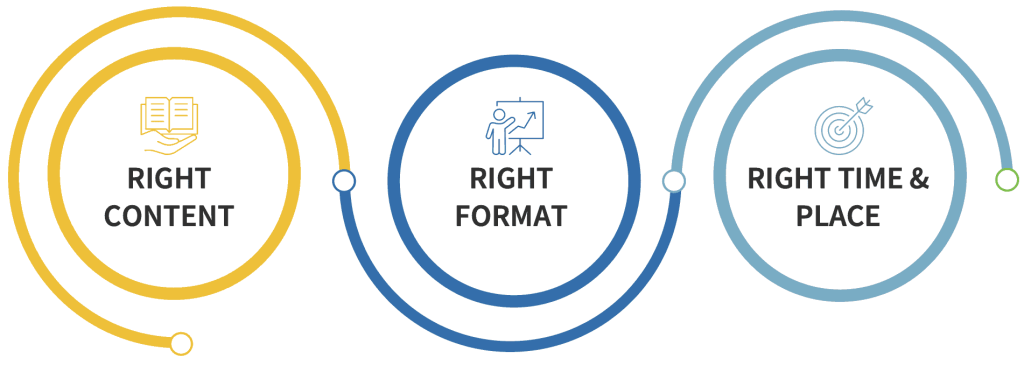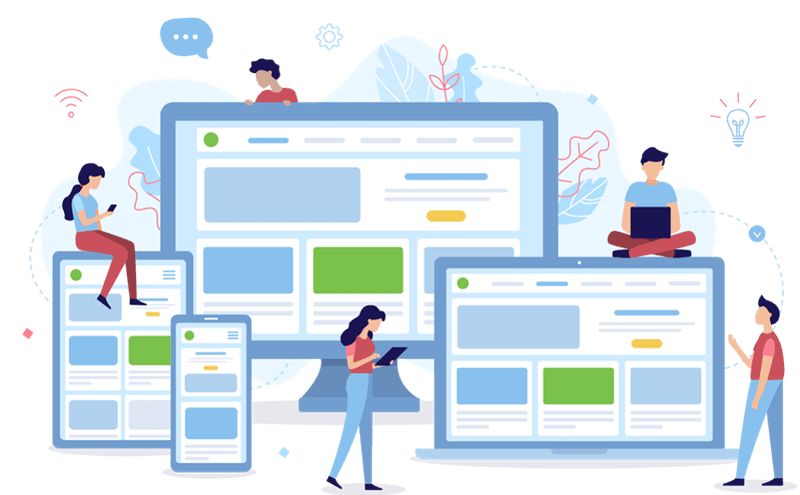
Leslie Farinella
Chief Strategy Officer
It is time to revolutionize how we design content. Organizations can only adapt as quickly as their workforce can learn new skills and adopt new mindsets. The ability to support rapid change requires us to fundamentally rethink how we design, develop, and deliver learning & support content throughout the enterprise.
We have lost sight of the most important factor in business transformation and agility — the content needed to drive change.
Successful digital transformation, agile response to business changes, and supporting a continuous learning culture requires adaptable content. Adaptable content can be used and reused efficiently in multiple experiences, across multiple audiences, and delivered in multiple formats, to meet the needs of a wide range of job roles, experience levels, geographies, and business use cases.

We need to stop designing content like a custom home builder and start designing content like a housing developer — creating content components that can be mix and matched to create a wide variety of experiences from a set of pre-configured options.
Marketing also adopted a new content paradigm and transformed how they reach their audiences — learning organizations need to do the same.
Organizations that are able to create more adaptable content will have a significant competitive advantage over their peers because they will be able to learn, change, and adapt faster — keeping pace with market changes.
New Model for Success
Many organizations continue to lock content into an inflexible, single-use format that can’t be reused or adapted to support new experiences. Competitive organizations will master the ability to deliver the right content, to the right people, in the right format, at the right time and place.

- Right content – the content is relevant to the audience based on their role, region, product, or task they are trying to perform. Large volumes of content can be quickly tailored to the exact content type and mix of information needed.
- Right format – the content matches the context of the learner — it’s a course for a novice, but it is skimmable for an expert, or it is a job aid for quick reference in the field. The content may be delivered in a variety of formats, such as SCORM, HTML, PDF, or even XML so it can be embedded in the applications the user is working in.
- Right place – the content is accessible when and where it is needed, which may be through the LMS or LXP, but it can also be accessed from a link in an email, fed to by a chat bot, or displayed in the tools people use every day.
Reimagining What Content Is
Organizations that can rethink content itself will gain tremendous speed to market.
The first step is to think differently about content itself — focus on the information and knowledge that organizations and customers need, not how that information looks on a page.
- Content is an explanation
- Content is an activity
- Content is a mental organizer
- Content is examples and non-examples
- Content is not the layout on the page
For content to be adaptable, the content itself must be format agnostic. Most tools trap content in a specific format and limit the ability to easily reuse and repurpose it. Content creators have confused content development with the layout on a page.
We can learn a lot from marketing – marketing starts with a campaign and writes modular content pieces that can be mixed and match to feed each of the experiences they want to create. Marketing doesn’t trap content into a single tool – they write adaptable content that can be fed to a wide variety of tools!
If learning wants to have the same reach and impact as marketing, we need to fundamentally shift the way we think about content creation today.

Organizations that are able to rethink the current content paradigm and move to processes that support more fluid content will be better suited to adopt to new digital content experiences and will have a distinct advantage over those that maintain the content status quo.
To build your content competitive advantage you need to be able to quickly tailor content for different audiences, experiences, and needs, create flexible content that can be rendered in many different formats, and support omnichannel distribution so you can get content into the hands of people when and where they need it.

1. Content needs to be tailored
Adaptable content can be tailored to the needs of the audience. Many organizations try to accomplish this today by simply making multiple copies of the same content pieces, each tailored to a different audience — novice/expert, office/field service, employee/partner. However, this approach is inefficient and, ultimately, unsustainable – we call this the content explosion.
The number of experiences content needs to support has multiplied and will only continue to grow. We must move beyond hand-crafted single purpose content to multiuse content that can be tailored to fit a wide range of needs. This will require us to think in terms of content components – think like a housing developer creating modules that can be mix and match together like Legos™ to create a wide variety of home designs.
Building a reusable library of content components takes time, but with the right strategy and technology in place, content teams can start small and build to their desired future-state over time. Let’s be honest, it wouldn’t be a competitive advantage if it was easy to do.
2. Content needs to be flexible
If you want flexible content, you need to create and store it in a flexible format, like XML. Forrester predicts that structured authoring will become the norm by 2027.
"The next decade will reveal new cloud-native, and structured approaches to document authoring — and enterprises need to get ready now."
Forrester – The Future of Documents

Ann Rockley, known as the mother of content strategy, defines structured authoring as writing information once and using it many times.Writing content in a flexible format will unleash the full power of your content.
Most tools used for content creation are WYSIWYG (What You See Is What You Get), which bundle content and layout together, causing content teams to start from scratch for every project. This is simply not sustainable, particularly at scale.
Structured authoring is the first step to being able to dynamically assemble content based on a user’s profile and context (where and when they are working). We see this already with in-app support; in-app alerts share the latest updates when we log in, offer the option to complete a guided activity to show us something new, or provide easy access to troubleshooting and suggestions related to the task at hand.
But someday soon content will be embedded within the applications where the task is being performed so users don’t need to leave the application they are in to lookup information or see a recent update. We will move to embedded content so when a novice is performing a task new to them, they will be presented with training and checklists related to that task. Whereas an expert completing the same task may only be presented with a notice for a recent process change. Content will be embedded within the applications where the task is being performed so users don’t need to leave the application they are in and to lookup information or see a recent update.
Pushing the content to people when and where they need it will drive change and agility throughout the organization. The first step to this future is writing your content so it is machine readable (structured authoring in XML).

3. Content needs to be accessible
Content is a competitive advantage when it is easily accessible – think omnichannel distribution.
We all know that putting a separate copy of the content in many different repositories creates a maintenance nightmare trying to keep all these copies in-sync. To scale, content needs to be fed from a central repository, so content is updated one-time at the source and keeps all places where the content is used in sync. This allows you to put content wherever it’s needed without increasing the overhead costs to maintain.
This shift to omnichannel distribution allows you to quickly and efficiently push out new information, build new skills, and drive change throughout your organization. Learning is no longer a separate task or event – learning becomes embedded in everything we do. Keeping your workforce updated with the pace of change.
The added advantage is that once content is served from a single source, you can track usage to better understand which delivery points are being used and which aren’t, and which groups are accessing the content and the correlation with performance. These rich data insights will allow you to refine engagement with learning audiences.
In order to truly turn content into a competitive advantage, a key mindset shift needs to occur.
When created, managed and delivered effectively, content is a competitive advantage that can drive change within your organization. To accomplish this, content needs to be adaptable to keep up with the changes in your business and the market. Creating adaptable content means rethinking how you create content today, and organizations that can make this paradigm shift sooner rather than later, will have a distinct competitive advantage in the marketplace.
Ready to get started? Schedule a free consultation with one of our content strategy experts today.

About Leslie Farinella
Leslie Farinella has more than 15 years of experience as a training strategy and design consultant, working with such organizations as GE, Citigroup, Johnson & Johnson, and Nielsen. With a background in engineering and an advanced degree in Curriculum and Instruction, she helps organizations re-imagine their content management strategy to optimize efficiency through the use of innovative techniques and technologies. Leslie’s expertise in business process change management, information architecture and teaching strategy helps Xyleme customers succeed on their journeys to high performance content.





